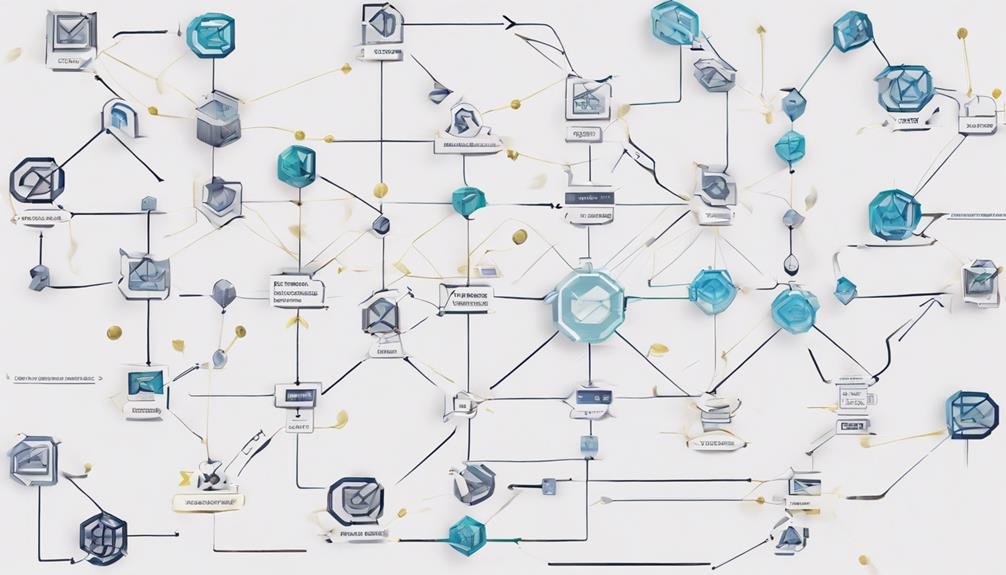If you’re new to blockchain, here are 7 simple ways to understand it: Blockchain is a digital ledger shared on many computers. Transactions are recorded in linked blocks. No single entity controls the decentralized network. Multiple participants validate and store transactions. Security is enhanced through Proof of Work. Blocks hold transaction data, and nodes validate information. Ledgers maintain transparent records. Wallets secure access keys. Consensus mechanisms guarantee transaction validity. Explore these basics further to uncover the transformative power of blockchain technology.
Brief Overview of How To Explain Blockchain To Newbies
- Start with basics: Learn how blockchain works and its decentralized nature.
- Understand key concepts: Focus on blocks, nodes, ledgers, wallets, and consensus mechanisms.
- Explore transaction process: Study data storage, encryption, verification, and network security.
- Grasp benefits: Discover enhanced security, transparency, and efficiency in transactions.
- Differentiate Bitcoin and Ethereum: Learn their origins, functions, and consensus mechanisms.
Basics of Blockchain Technology
To grasp blockchain technology’s fundamentals, consider it a digital ledger distributed across numerous computers on a decentralized network. This network records transactions in blocks, each linked to the previous one, forming a secure chain. The decentralized nature of blockchain guarantees that no single entity has control, providing transparency, immutability, and security in recording transactions. Multiple participants in the network validate and store transactions, reaching a consensus through mechanisms like Proof of Work (PoW).
Proof of Work is a consensus algorithm that enhances security by requiring participants to solve complex puzzles before adding new blocks to the chain. This process makes altering past blocks extremely difficult, safeguarding the integrity of the entire ledger. By distributing the ledger across multiple computers and establishing consensus protocols, blockchain technology creates a trustworthy system for recording transactions securely. The decentralized and transparent nature of blockchain and robust security measures like PoW underpins its reliability and resilience in the digital world.
Key Concepts of Blockchain

Key blockchain concepts include blocks, nodes, ledgers, wallets, and consensus mechanisms. Blocks hold transaction data, nodes validate, and store information and ledgers maintain transparent records. Wallets secure access keys, while consensus mechanisms guarantee transaction validity and network security.
Blockchain Basics
In a chronological chain, blocks are individual data units containing transactions in the blockchain. Nodes and devices linked to the network store a complete copy of the blockchain and verify transactions. The ledger records all transactions transparently, guaranteeing data integrity and security. Wallets hold private keys for managing cryptocurrencies securely.
Consensus mechanisms, like Proof of Work or Proof of Stake, guarantee agreement on transaction validity among network participants, maintaining blockchain integrity. Through these mechanisms, blockchain technology enables secure and transparent transactions, fostering trust in the system. Understanding these basic concepts forms the foundation for grasping blockchain technology’s broader implications and applications.
Decentralized Ledger Technology
Utilizing decentralized ledger technology, blockchain revolutionizes how transactions are recorded and verified across a network of computers. In this system, each transaction is stored in a block linked to the previous one, forming a block of blocks. Nodes, or computers in the network, validate these transactions. The ledger, distributed among all participants, maintains a transparent record of transactions.
Blockchain’s consensus mechanism guarantees that all network participants agree on the validity of transactions, enhancing security and trust. This decentralized approach means no single entity controls the network, providing immutability to stored data. Through blockchain technology, transparency, security, and trust are fostered in various applications, making it a groundbreaking innovation in the digital world.
Understanding Blockchain Transactions

Your data is stored in blocks linked with advanced cryptographic methods when transacting on a blockchain. Each of your secure transactions is encrypted and connected to the previous one, creating a secure chain of blocks. A network of decentralized nodes verifies and adds these transactions to the ledger, ensuring transparency and security.
Transaction Verification Process
To verify transactions in the blockchain, multiple nodes in the network engage in a consensus process to confirm the transaction’s validity. Here’s a breakdown to help you understand this process better:
- Consensus Mechanisms: Different methods like Proof of Work (PoW) and Proof of Stake (PoS) are used by nodes to agree on the validity of transactions.
- Transaction Broadcasting: When a transaction is proposed, it is shared with the network for validation by these nodes.
- Enhanced Security: Validating transactions guarantees that only legitimate ones are added to the blockchain, strengthening its security and trustworthiness.
Digital Ledger Technology
In blockchain technology, understanding digital ledger technology is key to comprehending how transactions are securely recorded and managed. Blockchain operates on a decentralized system where transactions are distributed across a network, ensuring no central authority has full control. Each transaction recorded on a blockchain is immutable, meaning it cannot be changed or deleted once it’s added. This immutability enhances the security and transparency of transactions, fostering trust among participants.
Through blockchain, various assets can be tracked globally, offering a reliable and efficient method for managing transactions. The decentralized nature of blockchain, coupled with its transparency and security features, makes it a powerful tool for conducting transactions in a trustworthy and efficient manner.
Immutable Record Keeping
Understanding how blockchain transactions are securely recorded in an immutable manner is crucial for grasping the concept of unchangeable record-keeping. Here are key points to help you comprehend this essential aspect:
- Blockchain transactions are time-stamped and cryptographically secured to maintain their integrity.
- Once a transaction is included in a block and verified by the network, it becomes a permanent record on the blockchain.
- The immutability of blockchain transactions guarantees that they cannot be altered or deleted, establishing a reliable audit trail for enhanced transparency, security, and trust.
Benefits of Blockchain Technology

With enhanced security and transparency, blockchain technology offers numerous benefits across various industries. The inherent security of blockchain, stemming from its decentralized and immutable nature, makes it extremely challenging for unauthorized parties to tamper with data, ensuring the integrity of information. This heightened security, coupled with the transparency of blockchain, where all transactions are traceable and verifiable, fosters trust among network participants.
By reducing reliance on intermediaries, blockchain enhances efficiency and cost-effectiveness in finance, supply chain management, and healthcare sectors. Smart contracts, a hallmark of blockchain technology, enable secure and automated execution of agreements without the need for intermediaries, further streamlining processes. The application of blockchain in diverse industries showcases its potential to revolutionize operations, improve data security, and drive innovation.
This technology promises to transform traditional practices, offering a more secure, transparent, and efficient way of conducting business.
Differences Between Bitcoin and Ethereum

When comparing Bitcoin and Ethereum, you’ll notice distinctive differences that set them apart in blockchain technology and cryptocurrency.
- Creation & Founders: Bitcoin was created in 2009 by an unknown person or group known as Satoshi Nakamoto, whereas Vitalik Buterin proposed Ethereum in late 2013.
- Primary Focus: Bitcoin primarily functions as a digital currency for peer-to-peer transactions. Ethereum serves as a platform for decentralized applications and smart contracts.
- Consensus Algorithm: Ethereum operates on a Proof of Stake (PoS) consensus algorithm, enabling faster transaction times and lower energy consumption, in contrast to Bitcoin’s Proof of Work (PoW).
These differences showcase how Bitcoin and Ethereum have unique approaches in the domain of digital currency, decentralized applications, and consensus mechanisms, making them prominent players in the blockchain space with distinct offerings for users and developers.
Exploring Blockchain Use Cases

Blockchain technology finds diverse applications across various industries, revolutionizing processes and enhancing security in digital transactions. In supply chain management, blockchain improves traceability, reduces fraud, and boosts efficiency. The healthcare sector utilizes blockchain to securely store patient records, manage drug supply chains, and safeguard data integrity. Financial institutions streamline transactions, increase transparency, and cut operational costs through blockchain.
Real estate industries benefit from blockchain for property transactions, smart contracts, and secure record-keeping. Blockchain transforms traditional finance and decentralized exchanges by enhancing security, transparency, and trust in digital transactions. Its impact extends beyond sectors, offering a reliable data integrity and transparency solution. As blockchain continues to evolve, its versatile applications empower industries to operate more securely and efficiently, making it a cornerstone for modern digital transactions.
How to Get Started With Blockchain

To start your journey into blockchain technology, begin by understanding the basic concepts underlying its decentralized structure and secure data storage mechanisms. Here’s how you can delve into the world of blockchain:
- Educate Yourself: Explore online resources and courses about blockchain technology, smart contracts, and consensus mechanisms. Understanding these fundamentals is essential for building a strong foundation.
- Hands-On Experience: Practice creating your blockchain projects using platforms like Ethereum or Hyperledger. This practical experience will deepen your understanding and hone your skills in blockchain development.
- Engage with the Community: Stay connected with the blockchain community through forums, meetups, and conferences. Networking with like-minded individuals will keep you informed about the latest trends and developments in the field.
Frequently Asked Questions
How Do You Easily Understand Blockchain?
To easily understand blockchain, start with basic concepts like decentralization and block structure. Explore key terms, practical uses, and real-world examples. Use visual aids, online resources, and interactive tutorials for hands-on exercises, debunking common misconceptions with simplified explanations.
How Do You Learn Blockchain for Beginners?
To learn blockchain for beginners, commence with the basics. Immerse yourself in understanding blockchain technology, explore consensus algorithms, grasp cryptocurrency basics, discover practical applications, and embrace the concept of decentralized networks. Peer-to-peer transactions await your exploration.
How Do You Explain Blockchain to a Layman?
To explain blockchain to a layman, consider it a digital ledger that securely records transactions across a network. It’s like a shared Excel sheet where everyone can see and verify changes, ensuring transparency and security.
How Blockchain Works Step by Step for Beginners?
Imagine creating data blocks, encasing them with encryption, linking them into a validation chain, and affirming transactions through a consensus mechanism. Peer-to-peer networks enable this decentralized ledger, ensuring secure smart contracts via a mining process and digital signatures.
Conclusion
Now that you’ve grasped the basics of blockchain technology think of it as a digital ledger that records transactions securely. It’s like having a personal diary where friends verify every entry to guarantee accuracy. So, whether buying a cup of coffee or trading cryptocurrencies, blockchain guarantees transparency and security in every transaction. Keep exploring this fascinating technology to unleash its full potential!










